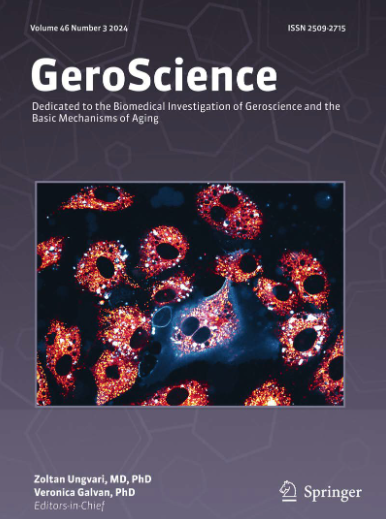烟酰胺核苷联合运动治疗中老年高血压:一项先导随机临床试验。
IF 5.4
2区 医学
Q1 GERIATRICS & GERONTOLOGY
引用次数: 0
摘要
有氧运动降低高血压成人血压(BP)有不同的效果,可能是由于年龄相关的烟酰胺腺嘌呤二核苷酸(NAD)代谢失调。本随机临床试验(RCT)测试了有氧运动联合NAD助推器烟酰胺核苷(NR)增强血压控制的效果。在这项双盲随机对照试验中,54名平均白天收缩压(SBP)≥130 mmHg的久坐成年人(≥55岁)被随机分为6周,1000 mg/天NR联合3天/周的监督30分钟步行运动(NR + Ex),安慰剂联合相同的运动方案(PL + Ex),或单独NR (NR)。主要终点为日间收缩压。其他结果包括脉搏波速度(PWV)、NAD分解代谢物和夜间血压。主要比较NR + Ex和PL + Ex。54名参与者(平均年龄67岁,61%为女性)中,49名(NR + Ex: n = 15, PL + Ex: n = 16, NR: n = 18)完成了所有的研究访问(93%坚持锻炼,90%坚持补充)。NR + Ex(平均变化= 5.19±13.2 mmHg)降低收缩压的效果不优于PL + Ex(- 2.71±10.5 mmHg)。NR + Ex(- 0.31±0.77 m/s)表现出更大的减小PWV的趋势。NR组NAD分解代谢产物水平较高。在事后分析中,NR + Ex显示出更大的夜间血压降低趋势(收缩压:- 9.6±9.22;舒张压:- 4.51±7.12 mmHg)。NR + Ex对中老年高血压患者降压效果不优于PL + Ex。然而,在未服用抗高血压药物的参与者中,NR + Ex夜间血压降低的趋势值得在IIb期随机对照试验中进一步研究。本文章由计算机程序翻译,如有差异,请以英文原文为准。
Nicotinamide riboside combined with exercise to treat hypertension in middle-aged and older adults: a pilot randomized clinical trial.
Aerobic exercise lowers blood pressure (BP) with varying effects in hypertensive adults, potentially due to age-related nicotinamide adenine dinucleotide (NAD) metabolism dysregulation. This pilot randomized clinical trial (RCT) tested the efficacy of combining aerobic exercise with the NAD booster nicotinamide riboside (NR) to enhance BP control. In this double-blinded RCT, 54 sedentary adults (≥ 55 years) with mean daytime systolic BP (SBP) ≥ 130 mmHg were randomized to 6 weeks of 1000 mg/day of NR combined with 3 days/week of supervised 30-min walking exercise (NR + Ex), Placebo combined with the same exercise regimen (PL + Ex), or NR alone (NR). The primary outcome was daytime SBP. Other outcomes included pulse wave velocity (PWV), NAD catabolites, and nighttime BP. The primary comparison was between NR + Ex and PL + Ex. Of 54 participants (mean age 67 years, 61% female), 49 (NR + Ex: n = 15, PL + Ex: n = 16, NR: n = 18) completed all study visits (93% adherence to exercise and 90% to supplementation). NR + Ex (mean change = 5.19 ± 13.2 mmHg) did not reduce SBP more than PL + Ex (- 2.71 ± 10.5 mmHg). NR + Ex (- 0.31 ± 0.77 m/s) showed a trend toward a greater reduction in PWV. Levels of NAD catabolites were higher in NR groups. In a post hoc analysis, NR + Ex showed a trend toward greater nighttime BP reductions (systolic: - 9.6 ± 9.22; diastolic: - 4.51 ± 7.12 mmHg) in participants without antihypertensive medications. NR + Ex was not superior to PL + Ex in reducing BP in hypertensive middle-aged and older. However, trends toward greater nighttime BP reduction in NR + Ex in participants without antihypertensive medication warrant further investigation in a Phase IIb RCT.
求助全文
通过发布文献求助,成功后即可免费获取论文全文。
去求助
来源期刊

GeroScience
Medicine-Complementary and Alternative Medicine
CiteScore
10.50
自引率
5.40%
发文量
182
期刊介绍:
GeroScience is a bi-monthly, international, peer-reviewed journal that publishes articles related to research in the biology of aging and research on biomedical applications that impact aging. The scope of articles to be considered include evolutionary biology, biophysics, genetics, genomics, proteomics, molecular biology, cell biology, biochemistry, endocrinology, immunology, physiology, pharmacology, neuroscience, and psychology.
 求助内容:
求助内容: 应助结果提醒方式:
应助结果提醒方式:


